Camp Parapet
| More information at Warlike, Wikidata, Wikipedia
HistoryIn the summer of 1861, Confederate forces made plans to defend the approaches to New Orleans from the north with a line of breastworks, to be fortified with up to 50 pieces of heavy ordnance. By late summer, fortifications were already erected from the Mississippi River north toward the swamp. These fortifications were described as being an extended parapet nine feet high fronted by a 30-foot-wide moat six feet deep. The line of breastworks had not been completed when Commodore Farragut's Union fleet broke through the two forts guarding the southern route to New Orleans and appeared before the city on 25 Apr 1862. Fleeing Confederate forces abandoned the unfinished defenses leaving behind the heavy artillery already emplaced. Fort John M. MorganConfederate Fort John M. Morgan was on the east bank of the Mississippi river bank at the southern terminus of the breastworks which stretched northward about 1.5 miles. The fort was officially named "Fort John Morgan" by New Orleans commander Major General Mansfield Lovell on 21 Mar 1862, just a month before Union forces arrived. The arriving Union forces found nine 42-pounders and two 32-pounders inside the fort, along with the remainder of the line, were nine 24-pounder carronades and four 18-pounders. All but nine of the cannons had been spiked by the retreating Confederates and all the carriages had been at least partially burned by them. There was some indication that the garrison had been removed to the south side of the city when it became apparent that Farragut's attack was coming from the south up the Mississippi. The magazine at the fort was found empty. A hotshot furnace was undisturbed at the site and about 1000 rounds of 32-pounder shot were found. Confederate gunners from the fort had carried away their remaining stores and left via the Jackson Railroad, minus their heavy artillery. The unnamed gun battery supporting the Fort Morgan on the other side of the Mississippi River was found in similar condition. That battery was replaced with the Union Fort Banks. Camp ParapetA November 1863 Union map of what the Union forces had come to describe as Camp Parapet included the completed breastworks with three fortifications along its length and several campgrounds behind the fortifications. The Union forces had upgraded the original Confederate defenses to protect against any attempt by the Rebels to retake New Orleans by coming down the Mississippi River. The Union Camp Parapet averaged some 3,500 troops at any one time during its operation.
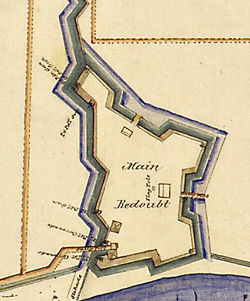 Main RedoubtAt the southern terminus was the former Fort John M. Morgan now referred to as the Main Redoubt. The Main Redoubt overlooked the Mississippi river at Nine Mile Point with a commanding view of any southbound river traffic but of little use against northbound traffic which is where Farragut's attack had come from. In 1865 the Main Redoubt is shown with three magazines, officer’s quarters, a guardhouse, an observatory, and a hot-shot furnace. The main powder magazine, which sat adjacent to the northeast wall of the enclosure, is the same one that is now restored in the Arlington Street park. Another magazine was situated against the wall in the southwest corner, while the third and smallest appears to be built into the northwest wall. The two smaller magazines may have stored extra arms and supplies rather than powder. The main magazine, however, was carefully constructed to resist explosive charges.
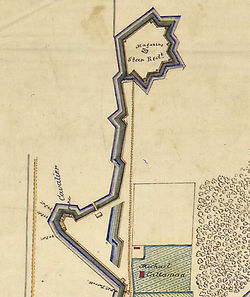 Star RedoubtAt the northern terminus of the line was the Star Redoubt. This fortification built as far north on the line as practicable. The Star Redoubt was a heavily armed 10-pointed star earthwork with a magazine at its center. It bordered on what was then a swamp and at times the fortification had standing water inside. The Star Redoubt was located near present-day 45th St. and N Causeway Blvd near Archbishop Rummel High School. A large portion of the labor for these improvements was contributed by former slaves who found refuge at the Federal camp. CavalierAlong the middle section of the line was a cavalier (a raised gun platform to protect the two redoubts and the middle of the line). Behind this well-armed line were a number of Union camps and facilities.
Post-U.S. Civil War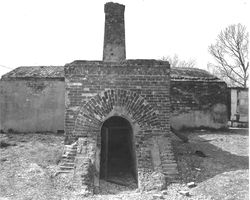 Camp Parapet was Abandoned as a fortification at the end of the war in 1865. From the late 1800s through the 1920s, the magazine of the former Fort John M. Morgan served as the Jefferson Parish East Bank Jail. Prisoners were held here until they could be transported to the West Bank Jail or were released. In 1963, the magazine was dedicated as a historical site by Jefferson Parish. In 1977, it was added to the National Register of Historic Places. It was restored in 1981.
Current Status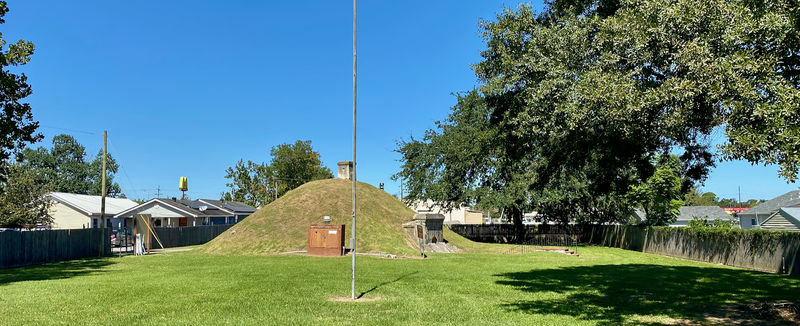 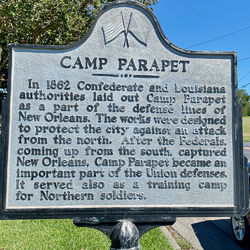 The Fort John M. Morgan powder magazine is the only remaining structure of Camp Parapet. It is located off Causeway Boulevard near the American Legion Post 267, preserved in a small park that was added to the National Register of Historic Places on 24 May 1977. The park is open to the public only one day of the year, the latest open house day was 2 Nov 2019. The 2020 day has been canceled.
See Also: Sources:
Links:
Visited: 30 Sep 2020 | |||||||
